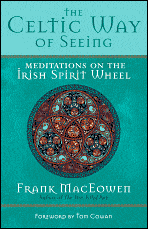
The Celtic Way of Seeing is an easy-to-read manual for bringing balance and harmony into your life. Author Frank MacEowan uses the analogy of a mandala, and integrates his position with similar concepts in Hindu, Native American and Buddhist teachings.
While the mandala is most commonly associated with Hindu art and spirituality, the concept of a circular design which leads the seeker to a deeper place of spiritual contact appears in other major religions. The Rose window in Chartres Cathedral is an example of a Christian mandala that has provided inspiration to viewers for many centuries. The Native American Medicine Wheel may be familiar example of a spirit wheel that not only touches spiritual chords with practitioners, but is used to provide healing answers to its seekers.
The Irish Spirit Wheel is a much simpler than the Native American Medicine Wheel, yet no less powerful in its healing capacity.
The four directions on the Irish Spirit Wheel “represent an ancient way of being, a Celtic way of seeing, a way of orienting to life’s energy, and a way of relating to the various experience, lessons and challenges on the soul’s journey.” Using the Irish Spirit Wheel will allow you a heightened connection to earth and the energies from the four directions.
Each of the four directions correspond to a particular energy, and in the second part of the book, the reader is taken through each of the Wheel segments, beginning in the Center with Sovereignty. Each of the remaining chapters offers short meditations and exercises to reinforce the key concepts.
Center is where we assimilate the energies of the four directions, and where we begin to know if we are unbalanced, out of harmony. Our relation to others, land and spirit is felt through our heart, at this starting point. This is not to say that we will always be in harmony, but returning to our “center” as a starting point when we recognize something is amiss, will begin the healing process.
East energy includes prosperity, the energy of your home and spaces and hospitality to others and to ourselves. MacEowen gives a very succinct overview of how our concept of prosperity is often viewed in terms of scarcity. He states that “our unbridled, unrefined consumerism becomes a self-fulfilling prophecy” as we seek to acquire more and more “things” to fill a void in our lives. Tending the householding energies is very similar to the ideas in Feng Shui, monitoring the energy in your home to ensure it’s harmonious and welcoming to you. Hospitality to oneself is truly taking care of yourself – a concept very difficult for people brought up to put the needs of others’ before their own.
In the South, the Great Song represents the Divine as well as music, inspiration and waterfalls. Its energy is the energy of falling in love with life. The energy of the South asks the question “…do you love any place or person so much that you will open your heart, eyes and mouth and say so?” Waterfalls are included in this energy, or rather, called out specifically, because of the energy that surrounds them. They are often considered transition points between the worlds, enabling us to shift our consciousness from the material plane, to the realm of spirit.The energy of West is knowledge, head knowledge certainly, but also heart knowledge. Celtic traditions delineate the West as the realm of spirits, ancestors and the Otherworld, so visionary knowledge, “seeing”, is associated with this direction. The energy includes the longing for re-union with the divine, what the Sufi poet Rumi wrote so eloquently about in his works. Calling the diving “Beloved”, he encapsulated the soul yearning for the Divine. Finally, the West includes the wisdom of counsel, the ability to seek guidance, from a real life friend or professional or one of the spirit realm.
The energy of the North, battle, is perhaps the energy we’re most familiar with but least able to work with. Whether it’s a confrontation with family or attempt to confront an addiction, the north is where we act out our warrior energies. We are all “warriors-in-training” according to Mr. MacEowen, and it is the north that our challenges, including our shadow work, are met and hopefully resolved.
At the end of this section are two practical applications for the Sprit Wheel, journaling, and actually making and using the Irish Sprit Wheel. Like the book itself, these two exercises seem simple on the surface, but actually have nuanced layers of meaning and of learning.
I found this book to be much more accessible and readable than Mr. MacEowen’s previous title “The Mist-Filled Path.” While it is a relatively quick read, the information and mediations are ones that a reader would easily return to, and the use of the Irish Spirit Wheel can be done in any space. I thought it was not just a worthwhile read, but a useful tool for working with these energies and for maintaining balance and harmony in your life.
~review by Karen Phillippi
By Frank MacEowen
New World Library, 2007
pp.141, $14.95
